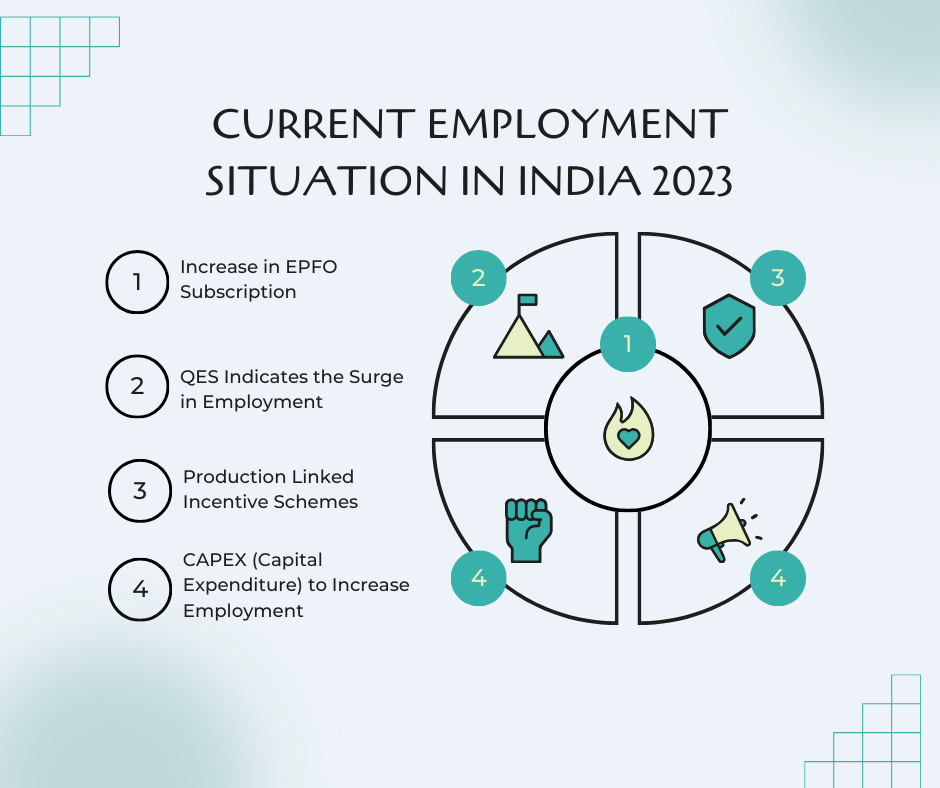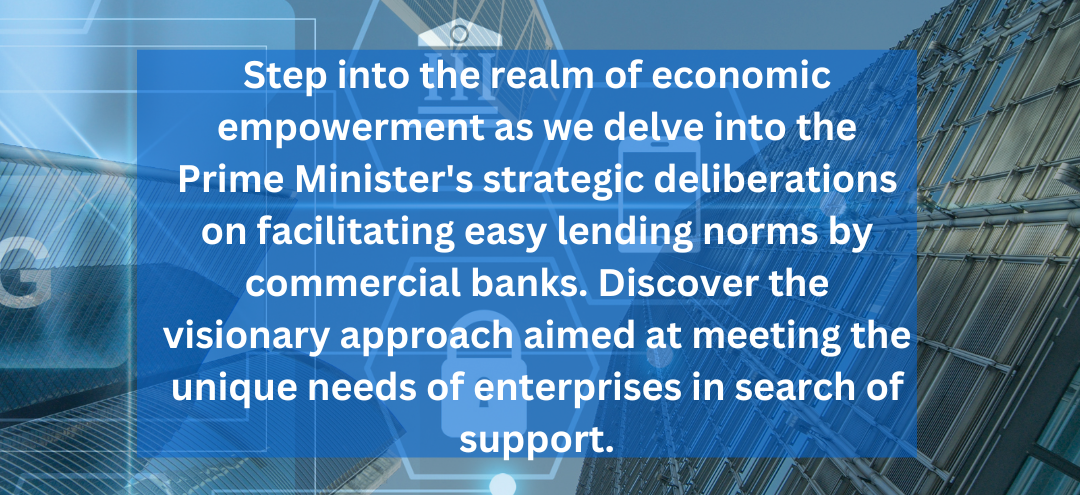According to the vision outlined by Prime Minister Modi, India is making significant strides towards achieving a $5 trillion economy by 2024-25. Under his leadership, the economic recovery in the country continues to have a positive impact on employment situation in New India, thanks to the multiplier effect.
Furthermore, the Budget for 2023-24 has injected strong momentum into economic growth with a substantial 33% increase in the country’s capital investment, now totaling Rs 10 lakh crores. This boost in capital investment is poised to not only stimulate economic activities but also enhance employment prospects across the nation.
The surge in employment opportunities in India is evident through various indicators, including increased job enrollments in the organized sector, a growing number of registered companies, the proliferation of startups, and the emergence of numerous Unicorns in the country. This expansion of employment opportunities extends to new sectors like AI, cloud computing, data analytics, automation, and more.
The employment situation in New India is constantly evolving, and the employment situation in 2023 has witnessed significant transformations.
Current Employment Situation in India 2023 | Current Employment Situation in India

According to the Economic Survey released in January 2023, the Indian economy’s GDP is projected to experience growth in the range of 6% to 6.8% during the fiscal year 2023-24. This projection is based on the evolving economic conditions and global political developments.
The Indian economy’s growth is primarily being driven by private consumption, capital formation, and capital investment. This positive momentum has led to increased employment opportunities and a reduction in urban unemployment rates, along with higher registrations in the Employee Provident Fund.
Additionally, the Mahatma Gandhi National Rural Employment Guarantee Scheme (MGNREGS) has played a crucial role in providing direct employment in rural areas, while also creating indirect job opportunities for rural households to diversify their income sources.
The recent consumer confidence survey conducted by the Reserve Bank of India (RBI) in October 2023 (results of September 2023) reflects improved contemporary and future employment and income conditions.
The highlights of the Consumer Confidence Survey are as follows –
- In September 2023, the Current Situation Index (CSI) achieved its highest level in four years, primarily due to survey participants expressing more positive evaluations of the current state of the overall economy and employment conditions.
- Anticipations regarding the overall economic outlook, employment opportunities, income, and spending are set to continue their positive trajectory in the coming year. The Future Expectations Index (FEI) likewise achieved its highest point in four years during the most recent survey round.
- Households maintain a strong sense of optimism about their future earnings, even though their current earnings sentiment has remained relatively stable at the levels observed in July 2023.
The employment rate in the country has shown growth during the current fiscal year, as supported by both official and unofficial sources. The Periodic Labour Force Survey (PLFS) indicates an increase from 50.7% in 2017-18 to 60.8% in 2022-23, whereas in urban areas, it increased from 47.6% to 50.4%. The LFPR for males in India increased from 75.8% in 2017-18 to 78.5% in 2022-23, while the corresponding increase in LFPR for females went from 23.3% to 37.0%. Moreover, the Labor Force Participation Rate (LFPR) has improved, indicating a positive trajectory for the Indian economy despite the initial pandemic-induced slowdown in early FY 2023.
According to the Overview of the Union Budget for the fiscal year 2023-24, increased investments in infrastructure and enhancing productive capacity have a substantial multiplier effect on both economic growth and employment. Furthermore, the government plans to set upto 100 laboratories within engineering institutions to focus on developing applications utilizing 5G services. This initiative aims to tap into a wide array of new opportunities, business models, and, importantly, employment prospects. These laboratories will encompass areas such as smart classrooms, precision farming, intelligent transport systems, and healthcare applications.
Significant aspects revealing Employment Situation of the Country:
1. Increase in EPFO Subscription
As on October 2023, 498058 total EPFO registration has been done and as on April 2023, the total new subscriber during March 2023 accounted to be 7,57,792, out of which, 5,67,149 were males and 1,90,630 were females. The newly joined members belong from the age of 18-21 years comprising 2,34,720, followed by the 22-25 years age group comprising 1,94,216.
In May 2023, 10,08,693 members have rejoined the EPFO membership, showing a significant increase compared to the previous year. These members have commutated their jobs and rejoined the establishments covered under EPFO and opted to transfer their accumulations rather than applying for final settlements. Therefore, extending the scope of social security protection.
2. QES Indicates the Surge in Employment
A “quarterly bulletin” refers to a periodic publication or report issued by an organization, such as a government agency, central bank, or a company, that provides information, analysis, and estimates about various economic, financial, or other relevant indicators for a specific quarter or three-month period. The term “estimates” in the context of a quarterly bulletin typically pertains to projections, forecasts, or assessments made by the organization regarding trends, statistics, or other data for the upcoming quarter or future periods. These estimates can include economic growth forecasts, inflation predictions, employment figures, trade balances, and more, which are essential for stakeholders, policymakers, and the public to understand and make informed decisions.
The current Quarterly Bulletin (published by National Sample Survey Office) is the 18th in the series for the quarter January–June 2023. The significant finding of the QES is –
| Survey period | Male | Female | Person |
| (1) | (2) | (3) | (4) |
| April – June 2022 | 73.5 | 20.9 | 47.5 |
| July – September 2022 | 73.4 | 21.7 | 47.9 |
| October – December 2022 | 73.3 | 22.3 | 48.2 |
| January – March 2023 | 73.5 | 22.7 | 48.5 |
| April – June 2023 | 73.5 | 23.2 | 48.8 |
Key Findings of PLFS, Quarterly Bulletin (April –June2023) –
A. Increasing Trend in Labour Force Participation Rate (LFPR)
The “Labor Force Participation Rate,” often referred to as the “Worker Population Ratio,” is a statistical measure that calculates the percentage of the working-age population (typically those aged 16 to 64 or 15 to 64, depending on the country’s definition) that is either employed or actively seeking employment. It is used to assess the proportion of people within a specific age group who are engaged in the labor force, which includes those who have jobs or are actively looking for work. This ratio is a key indicator in labor market analysis and provides insights into the economic participation of a particular demographic group within a given region or country
B. Increasing Trend in Worker Population Ratio (WPR)
WPR (in percent) in CWS in urban areas for persons of age 15 years and above –
| Survey period | Male | Female | Person |
| (1) | (2) | (3) | (4) |
| April – June 2022 | 68.3 | 18.9 | 43.9 |
| July – September 2022 | 68.6 | 19.7 | 44.5 |
| October – December 2022 | 68.6 | 20.2 | 44.7 |
| January – March 2023 | 69.1 | 20.6 | 45.2 |
| April – June 2023 | 69.2 | 21.1 | 45.5 |
C. Decreasing Trend in Unemployment Rate (UR)
The “Unemployment Rate” is a widely used economic indicator that measures the percentage of the labor force that is currently without a job and actively seeking employment. It is typically calculated by dividing the number of unemployed individuals by the total labor force (the sum of employed and unemployed individuals). This rate serves as a critical measure of the health of an economy and its labor market. A higher unemployment rate often indicates economic challenges, while a lower rate suggests a more robust job market. Economists and policymakers closely monitor the unemployment rate to gauge the overall economic conditions and labor force dynamics in a specific region or country.
UR (in per cent) in CWS in urban areas for persons of age 15 years and above –
| survey period | Male | Female | Person |
| (1) | (2) | (3) | (4) |
| April – June 2022 | 7.1 | 9.5 | 7.6 |
| July – September 2022 | 6.6 | 9.4 | 7.2 |
| October – December 2022 | 6.5 | 9.6 | 7.2 |
| January – March 2023 | 6.0 | 9.2 | 6.8 |
| April – June 2023 | 5.9 | 9.1 | 6.6 |
3. Production Linked Incentive Schemes (PLI)
The Production Linked Incentive Schemes have been introduced by the Government of India in order to enhance production and economic growth, hence, increasing in employment of the country. As of June 2023, the value addition of 20% has been recorded in mobile manufacturing within the duration of 3 years.
Till March 2023, the actual investment of Rs. 62,500 crores has led to increased production or sales of above Rs. 6.75 lakh crores. This has resulted in the employment generation of about 3,25,000.
In FY 2022-23, about Rs 29000 crore has been disbursed under PLI schemes for 8 sectors, i.e.,
- Large-Scale Electronics Manufacturing (LSEM),
- IT Hardware,
- Bulk Drugs,
- Medical Devices,
- Pharmaceuticals,
- Telecom & Networking Products,
- Food Processing,
- Drones & Drone Components.
All the sectors approved and designated within the PLI (Production-Linked Incentive) Schemes adhere to a comprehensive set of criteria that emphasize prioritizing essential technologies in which India can make significant advancements, leading to increased employment opportunities, higher exports, and broader economic advantages for the country. These sectors received approval after rigorous assessment by NITI Aayog and extensive discussions with relevant Ministries and Departments. As of the current date, there have been no proposals approved by the Union Cabinet to introduce additional sectors into the PLI Schemes.
These sectors are (i) Mobile Manufacturing and Specified Electronic Components, (ii) Critical Key Starting Materials/Drug Intermediaries & Active Pharmaceutical Ingredients, (iii) Manufacturing of Medical Devices (iv) Automobiles and Auto Components, (v) Pharmaceuticals Drugs, (vi) Specialty Steel, (vii) Telecom & Networking Products, (viii) Electronic/Technology Products, (ix) White Goods (ACs and LEDs), (x) Food Products, (xi) Textile Products: MMF segment and technical textiles, (xii) High efficiency solar PV modules, (xiii) Advanced Chemistry Cell (ACC) Battery, and (xiv) Drones and Drone Components.
The Indian Government’s Production Linked Incentive (PLI) Schemes aim to stimulate production, economic growth, and employment. By June 2023, a 20% value addition in mobile manufacturing has been achieved. Investments of Rs. 62,500 crores till March 2023 have led to over Rs. 6.75 lakh crores in production and the creation of approximately 3,25,000 jobs across 8 sectors. These sectors were chosen after thorough assessments by NITI Aayog and relevant Ministries, and there have been no new additions to the PLI Schemes as of the current date. In summary, the PLI Schemes are driving economic growth and job opportunities in India.
4. CAPEX (Capital Expenditure) to Increase Employment

In order to further boost the positive feedback loop of investment and job creation, the budget has taken the initiative once more by significantly raising the capital expenditure allocation. The budget for the fiscal year 2023-24 has witnessed a substantial increase of 37.4%, amounting to a staggering Rs. 10 lakh crore, compared to the Rs. 7.28 lakh crore in the Revised Estimates for 2022-23.
a. Capital Investment as a driver of growth and jobs
To stimulate investments and create jobs, the 2023-24 budget is increasing spending on big projects by 37.4%. They plan to allocate 10 lakh crore rupees, a big jump from the 7.28 lakh crore rupees spent in the previous year.
b. Startup Ecosystem
The Start-up India initiative launched on January 16, 2016, which includes 16 Action Points act as a guiding force for this initiative. The pre-eminent agenda behind the introduction of this initiative was to empower startups to grow with the assistance of technology and design.
Moreover, the scope of this initiative is not limited to startups, but it also has a catalytic effect on the Indian startup ecosystem and accelerates Indian entrepreneurs to build innovative solutions to fulfill domestic and global needs.
Apart from that, distinct measures have been taken under the Startup India initiative to transform India into a country of “job creators” rather than a county of “job seekers.”
India has emerged as the 3rd largest startup ecosystem globally in April 2023, containing over 115,064 DPIIT-recognized startups as on November 2023. India ranks in the 2nd position in innovation quality, holding the top position in terms of quality of scientific publications and quality of universities among other middle-class economies. Moreover, it is to be noted that innovation in India is not restricted to certain sectors, but it is being recognized that Indian startups have successfully resolved the issues of 56 diversified sectors. In FY 2023 (Q1 to Q3), Indian startups raised $7 billion fundings.
In addition to that, in the past few years, India’s startup ecosystem has reflected tremendous growth (2019-2022 till date) –
- Total funding of startups has increased by 15X.
- The number of investors has increased by 9X.
- The number of incubators has increased by 7X.
The Indian unicorns (a term used to describe a privately owned startup company with a valuation of over $1 billion) are also flourishing in a fast-paced manner since these startups are not only developing or proposing innovative solutions and advanced technologies but are also contributing to the employment generation at a large scale. As of October 2023, India had a total of 1,12718 unicorns accounting for a valuation of $349.67 billion.
c. Aviation Sector
In accordance with the UDAN scheme, a target has been set to establish at least 100 airports or heliports, or waterdromes by FY 2024. As of January 31, 2023, a total of 73 airports, including 9 heliports and 2 water aerodromes, that were previously unserved or underserved have been made operational through the UDAN scheme since 2017. It’s important to note that the UDAN scheme is an ongoing initiative, with periodic bidding rounds aimed at expanding its coverage to include additional destinations, stations, and routes.
This growth in the aviation sector will result in an increase in the demand for a more trained workforce such as pilots, cabin crew, aircraft maintenance engineers, airport professionals, and IT and support service professionals.
Therefore, it will improve the employment situation in new India, while contributing to economic growth.
d. Make in India
Make in India, is an initiative launched in September 2014 by the government of India to facilitate investment, stimulate innovation, and build the best-in-class manufacturing infrastructure with the purpose to promote ease of doing business and enhance the development of skills.
Furthermore, “Make in India” also seeks a creative environment for investment, and advanced and efficient infrastructure, including the establishment of new sectors to lure foreign investments and forging a partnership between government and industry.
In simpler words, it is a solitary “Vocal for Local” approach introduced with the purpose to promote manufacturing in India to maximize the economic growth of the country but also to provide employment opportunities for our young labor force.
e. Banking Sector
India has seen steady growth in the number of branches of banks, which has a direct correlation with the increase in employment.
The provided data shows a positive trend in the current employment situation in India 2023, certainly improved if compared to the current employment situation in India 2023. From growth in bank branches to initiatives such as Startup India/ Make in India, India’s economy is reflecting growth in the rate of employment.
Significant Schemes/ Sectors Contributing in Employment Generation
Certainly, India’s diverse economic sectors have been instrumental in employment generation, contributing significantly to the country’s job market. The “Digital India” initiative has propelled growth in the information technology and services sector, creating a multitude of job opportunities in software development, cybersecurity, and digital marketing.
“Skill India” has been instrumental in upskilling the workforce and fostering employment situation in New India across various sectors by providing training in industries like manufacturing, healthcare, and retail. India is now prioritizing substantial investments in the skill development of its youth like never before. One of the schemes under “Skill India” – Pradhan Mantri Kaushal Vikas Yojana, which has significantly empowered the nation’s young talent at the grassroots level. As part of this program, the Hon’ble Prime Minister revealed that approximately 1.5 crore young individuals have undergone skill training to date. Furthermore, new skill centers will be established in close proximity to industrial hubs, enabling seamless collaboration between industries and skill development institutes. This collaborative approach aims to equip the youth with the necessary skills required for improved employment situation in New India.
Artificial Intelligence (AI) is driving the growth of data science and AI-related jobs, offering opportunities in machine learning, data analysis, and automation. Robotics, including medical robotics, is reshaping industries and employment. In manufacturing, robots improve efficiency, creating jobs for engineers and technicians. Medical robotics enhances healthcare, requiring skilled professionals for operation. Research and development in robotics demand engineers and AI experts. Service and social robots, from customer service to education, open opportunities in maintenance and programming. Robotics contributes to employment across diverse sectors, from healthcare to research and service industries.
The agriculture sector, on the other hand, continues to be a significant source of employment for millions of farmers, laborers, and agribusiness professionals, especially in rural areas. India’s agriculture sector plays an important role in the world economy and is the fundamental source of occupation for around 60% of the rural population. The country comprises 2nd largest agriculture land globally employing over half of country’s population.
The renewable energy sector has not only contributed to sustainable energy solutions but also created jobs in solar panel manufacturing, wind turbine maintenance, and research in green technologies. In the pharmaceutical and healthcare sector, research, drug manufacturing, and healthcare services have led to job opportunities for scientists, pharmacists, doctors, and healthcare professionals. Currently, Green Hydrogen production in the country is in the research and development (R&D) and pilot phases, resulting in limited foreign currency savings and employment situation in New India. However, the National Green Hydrogen Mission sets ambitious objectives, aiming to achieve savings of approximately Rs 1 lakh crore through reduced imports and the creation of around 6 lakh jobs by the year 2030. As per the ‘Renewable Energy and Jobs Annual Review 2022’ by the International Renewable Energy Agency (IRENA), the biogas sector in India contributed to the creation of 85,000 jobs.
E-commerce and the tech industry have given rise to jobs in logistics, online retail, app development, and customer service. The financial technology (FinTech) sector is fostering employment in financial services, including digital banking, payment processing, and financial analytics. Space exploration and satellite technology have opened avenues for engineers, scientists, and space professionals.
The biotechnology and telemedicine sectors, catalyzed by the COVID-19 pandemic, have created jobs in research, vaccine production, and telehealth services, enhancing the healthcare industry and generating employment situation in New India for healthcare workers and technology specialists.
These sectors represent a vast spectrum of job opportunities, ranging from highly technical and specialized roles to labor-intensive positions, collectively contributing to employment generation and the economic advancement of India.
Measures to Increase Employment in India
Employment Generation Schemes/ Programmes of the Government of India
| Sr. No. | Name of the Scheme/ Programme | Ministry | About Scheme |
| 1 | Atmanirbhar Bharat Rojgar Yojana (ABRY) | Ministry of Labour and Employment | The scheme was launched in October 1st, 2020 as part of Atmanirbhar Bharat Package 3.0 with the objective to incentivize employers to generate new employment along with social security benefits and restoration of loss of employment during the Covid-19 pandemic. Website link – https://labour.gov.in/aatmanirbhar-bharat-rojgar-yojana-abry |
| 2 | National Career Service (NCS) Project | Ministry of Labour and Employment | The portal has been introduced to transform the National Employment Service in order to provide distinct career-related services like job matching, career counseling, vocational guidance, information on skill development courses, apprenticeships, internships, etc. It includes three significant components – NCS Portal (www.ncs.gov.in); Model Career Centres; and Interlinking of Employment Exchanges. Website link – https://www.ncs.gov.in/ |
| 3 | Mahatma Gandhi National Rural Employment Guarantee Act (MGNREGA) | Ministry of Rural Development | MGNREGA is projected to provide at least 100 days of guaranteed wage employment in a financial year to every rural household whose adult members volunteer to do unskilled manual work. Website link – https://nrega.nic.in/MGNREGA_new/Nrega_home.aspx |
| 4 | Pt. Deen Dayal Upadhyaya Grameen Kaushlya Yojana (DDU-GKY) | Ministry of Rural Development | DDU-GKY is a placement-linked skill development program launched for rural poor youth (covering the age group of 15-35 years) under the National Rural Livelihoods Mission (NRLM) in September 2014. Website link – http://ddugky.info/ |
| 5 | PM- SVANidhi Scheme | M/o Housing & Urban Affairs | PM SVANidhi Scheme was launched on June 01, 2020, to offer collateral-free working capital loans to Street Vendors, vending in urban areas, to resume their businesses which were adversely affected due to the COVID-19-induced lockdown. Website Link – https://pmsvanidhi.mohua.gov.in/ |
| 6 | Prime Minister’s Employment Generation Programme (PMEGP) | Ministry of Micro, Small & Medium Enterprises | PMEGP which is a major credit-linked subsidy programme targets to generate self-employment opportunities through establishment of micro-enterprises in the non-farm sector by helping traditional artisans and unemployed youth. Website Link – https://msme.gov.in/1-prime-ministers-employment-generation-programme-pmegp |
| 7 | National Apprenticeship Promotion Scheme (NAPS) | Ministry of Skill Development and Entrepreneurship | NAPS was launched in August 2016 to promote the Apprenticeship in India by providing financial incentives, technology and advocacy support. The scheme has the following two components – Sharing of 25% of prescribed stipend subject to a maximum of Rs. 1500/- per month per apprentice with the employers and Sharing of basic training cost up to a maximum of Rs. 7,500 per apprentice. Website Link – https://msde.gov.in/en/schemes-initiatives/apprenticeship-training/naps |
| 8 | Production-Linked Incentive (PLI) Scheme | 13 Ministries | Production Linked Incentive (PLI) Schemes has been announced by Hon’ble Finance Minister, Smt Nirmala Sitharaman with an outlay of INR 1.97 Lakh Crores across 14 key sectors with the motto to create national manufacturing champions and to create 60 lakh new jobs, and an additional production of 30 lakh crore during next 5 years. Website Link – https://www.investindia.gov.in/production-linked-incentives-schemes-india |
Flagship programmes of the Government that have the potential to generate productive employment opportunities
| 1 | Digital India | Ministry of Electronics and Information Technology | it is a flagship programme of the Government of India introduced with a vision to transform India into a digitally empowered society and knowledge economy. Website Link – https://www.digitalindia.gov.in/ |
| 2 | Atal Mission for Rejuvenation and Urban Transformation (AMRUT) | Ministry of Housing and Urban Affairs | The AMRUT mission was been introduced with the mission to provide basic services (e.g. water supply, sewerage, urban transport) to households and build amenities in cities to improve the quality of life for all, especially the poor and the disadvantaged is a national priority. Website Link – http://tcpo.gov.in/atal-mission-rejuvenation-and-urban-transformation-amrut-reforms |
| 3 | Make in India | DPIIT, Ministry of Commerce & Industry | ‘Make in India’ initiative was launched on September 25, 2014 to facilitate investment, boost innovation, building best in class manufacturing infrastructure, ease of doing business and improving skill development. Website Link – https://www.makeinindia.com/ |
| 4 | Smart Cities | Ministry of Housing & Urban Affairs | The primary motive of the Mission is to promote cities that provide core infrastructure, clean and sustainable environment and give a decent quality of life to their citizens through the application of ‘smart solutions’. Website Link – https://smartcities.gov.in/ |
| 5 | Shyama Prasad Mukherji Rurban Mission | M/o Rural Development | SPMRM follows the vision of Development of a cluster of villages that conserves and nurture the essence of rural community life emphasizing on equity and inclusiveness without compromising with the facilities perceived to be essentially urban in nature. Website Link – https://rurban.gov.in/#gsc.tab=0 |
| 6 | The National Industrial Corridor | Ministry of Commerce & Industry | To coordinate the development of the industrial corridors, with smart cities linked to transport connectivity, drive India’s growth in manufacturing and urbanization. Website Link – https://www.nicdc.in/ |
| 7 | Stand up India Scheme | Department of Financial Services, Ministry of Finance): | It is a Scheme for financing SC/ST and/or Women Entrepreneurs with the motto to facilitate bank loans between 10 lakh and 1 Crore to at least one Scheduled Caste (SC) or Scheduled Tribe (ST) borrower and at least one woman borrower per bank branch for setting up a greenfield enterprise. Website Link – https://www.standupmitra.in/ |
| 8 | Start Up India | DPIIT, Ministry of Commerce & Industry | It is a flagship initiative of the Government of India, intended to catalyse startup culture and build a strong and inclusive ecosystem for innovation and entrepreneurship in India. Website Link – https://www.startupindia.gov.in/ |
| 9 | Pradhan Mantri Awas Yojana – Urban | Ministry of Housing & Urban Affairs | It is a flagship Mission of Government of India being implemented by Ministry of Housing and Urban Affairs (MoHUA), was launched on 25th June 2015. Its mission is to address urban housing shortage among the EWS/LIG and MIG categories including the slum dwellers by ensuring a pucca house to all eligible urban households by the year 2022, when Nation completes 75 years of its Independence. PMAY(U) adopts a demand driven approach wherein the Housing shortage is decided based on demand assessment by States/Union Territories. Website Link – https://pmay-urban.gov.in/about |
| 10 | Swachh Bharat Mission- Grameen | Ministry of Jal Shakti | To accelerate the efforts to achieve universal sanitation coverage and to put the focus on sanitation, the Prime Minister of India had launched the Swachh Bharat Mission on 2nd October 2014. Under the mission, all villages, Gram Panchayats, Districts, States and Union Territories in India declared themselves “open-defecation free” (ODF) by 2 October 2019, the 150th birth anniversary of Mahatma Gandhi, by constructing over 100 million toilets in rural India. Website Link – https://swachhbharatmission.gov.in/sbmcms/index.htm |
| 11 | Swachh Bharat Mission – Urban (SBM-U), | Ministry of Housing & Urban Affairs | SBM-U launched on 2nd October 2014 targets to make urban India free from open defecation and achieving 100% scientific management of municipal solid waste in 4,041 statutory towns in the country. Website Link – https://mohua.gov.in/cms/swachh-bharat-mission.php#:~:text=The%20Swachh%20Bharat%20Mission%20%2D%20Urban,Elimination%20of%20open%20defecation |
| 12 | Pradhan Mantri Garib Kalyan Yojana (PMGKY) | Ministry of Labour and Employment | PMGKY is a scheme introduced by the Government of India which has contributed in both 12% employer’s share and 12% employee’s share under Employees Provident Fund (EPF), totaling 24% of the wage for the wage month from March to August, 2020 for the establishments having upto 100 employees with 90% of such employees earning less than Rs. 15000/-. Website Link – https://www.epfindia.gov.in/site_docs/PDFs/Circulars/Y2020-2021/SchemeCOVID_24_10042020.pdf |
Conclusion
In conclusion, India is making remarkable strides in achieving its vision of becoming a $30 trillion economy in next 30 years or $5 trillion economy by 2024-25, thanks to strong leadership and proactive economic policies. The recent budget for 2023-24 has injected a significant impetus into economic growth with a substantial increase in capital investment, which is set to stimulate economic activities and enhance employment situation in New India throughout the nation. India’s employment landscape is constantly evolving, and the employment situation in 2023 has witnessed substantial transformations.
The Indian economy’s growth is primarily driven by factors like private consumption, capital formation, and capital investment. This positive momentum has translated into increased employment situation in New India and reduced urban unemployment rates, alongside higher registrations in the Employee Provident Fund. The Mahatma Gandhi National Rural Employment Guarantee Scheme (MGNREGS) has played a pivotal role in providing direct employment in rural areas and creating indirect job opportunities for rural households.
The Consumer Confidence Survey, conducted by the Reserve Bank of India (RBI), reflects improved contemporary and future employment and income conditions. Households in India maintain a strong sense of optimism about their future earnings, signaling positive growth in the employment sector.
Moreover, various government schemes and initiatives are instrumental in creating employment opportunities across the country. Schemes like Atmanirbhar Bharat Rojgar Yojana (ABRY), Pradhan Mantri Rojgar Protsahan Yojana (PMRPY), National Career Service (NCS), and Mahatma Gandhi National Rural Employment Guarantee Act (MGNREGA) have been essential contributors to job creation.
India’s startup ecosystem is booming, and the country ranks as the 3rd largest startup ecosystem globally. The surge in unicorns and the growth in various industries, such as renewable energy, biotechnology, and telemedicine, have created numerous job opportunities. The Production Linked Incentive (PLI) Schemes introduced by the government aim to stimulate production, economic growth, and employment, with significant results already evident.
Other initiatives like Digital India, Skill India, Make in India, and the Smart Cities mission are fostering employment in sectors like information technology, manufacturing, and urban development. The rise of sectors like artificial intelligence, agriculture, and robotics further contributes to employment generation and the economic advancement of the nation.
In summary, India’s employment landscape is on a positive trajectory, with a diversified range of schemes and sectors actively contributing to job creation and the country’s economic growth. India’s journey towards becoming a $5 trillion economy by 2024-25 is not just a vision; it’s a testament to the nation’s commitment to providing better employment situation in New India for its citizens and driving economic prosperity.
Written & Compiled by CA Sunil Kumar Gupta
Founder Chairman, SARC Associates







0 Comments